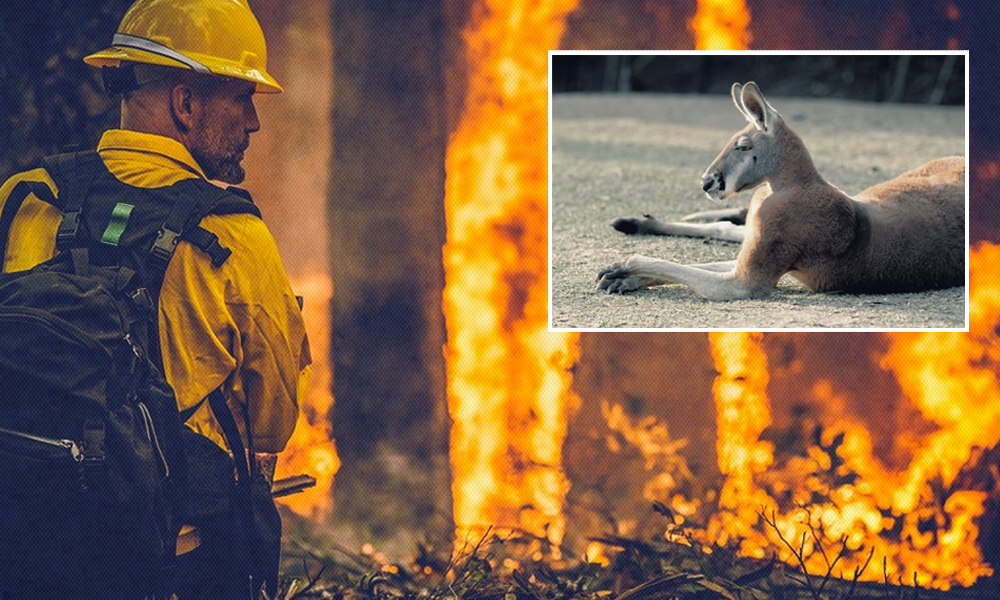
Nearly Three Billion Animals Affected By Australian Bushfires: WWF Study
Writer: Reethu Ravi
Reethu, a story teller, a person often found between the pages of a book or contemplating the nuances of life.
India, 29 July 2020 2:22 PM GMT
Editor : Shubhendu Deshmukh |
Shubhendu, the quint essential news junky, the man who loves science and politics in equal measure and offers the complete contrast to it by being a fan of urdu poetry as well.
Creatives : Abhishek M
" An engineer by profession, Abhishek is the creative producer of the team, graphic designing is his passion and travelling his get away. In more ways than one, he makes the content visually appealing."
The new figures are almost three times an earlier estimate of 1.2 billion released in January.
Australia's devastating bushfire season of 2019 and 2020 have killed or displaced nearly 3 billion animals, a new study by the World Wide Fund for Nature (WWF) said on Tuesday, July 28. This is the first time that the scale of the impact on the country's wildlife in the bushfires has been revealed.
The new figures are almost three times an earlier estimate of 1.2 billion released in January.
An estimate of 143 million mammals, 2.46 billion reptiles, 180 million birds, and 51 million frogs have perished in the bushfire, the WWF said in an interim report titled Australia's 2019-2020 Bushfires: The Wildlife Toll.
In the devastating bushfires, up to 19 million hectares were burnt, with 12.6 million hectares primarily forest and bushland. In addition, 34 lives were lost and around 2,700 homes were destroyed.
"Particularly devastating impacts on biodiversity and human life occurred in eastern Australia, with around 12.6 million hectares containing primarily forest and woodland burning. The World Wide Fund for Nature commissioned this report to estimate the number of individual native vertebrates that would have been present within the bushfire impact area to estimate the numbers of individual animals that may have been killed or affected as a result," the WWF said.
For the report, the majority of the work was contributed by 10 scientists from the University of Sydney, University of New South Wales, University of Newcastle, Charles Sturt University, and BirdLife Australia. The project is being led by the University of Sydney researchers Lily Van Eeden and Chris Dickman.
The report said that several techniques were used to estimate the figures. While mammal numbers were based on published data on the densities of each species in different areas, bird numbers were derived from BirdLife Australia data based on nearly 104,000 standardised surveys. Meanwhile, the reptile estimates were modelled using the knowledge of environmental conditions, body size and a global database of reptile densities.
The WWF said that while the results are still being finalised, the three billion figure is unlikely to change. The scientists added that the number of invertebrates, fish and turtles affected was not estimated due to a lack of relevant data and that their estimates were conservative due to limitations in the methodologies used.
"The interim findings are shocking. It's hard to think of another event anywhere in the world in living memory that has killed or displaced that many animals. This ranks as one of the worst wildlife disasters in modern history," said WWF-Australia CEO Dermot O'Gorman.
Dickman, a professor in ecology at the University of Sydney and fellow of the Australian Academy of Science, said, "When you think about nearly three billion native animals being in the path of the fires it is absolutely huge, it's a difficult number to comprehend."
The professor added that while the scientists cannot say how many animals died, the prospects for animals which escaped the flames were "probably not that great" because of a lack of food and shelter or being forced into habitat already occupied.
While in January, Professor Dickman and scientists from WWF produced an early estimate that 1.25 billion animals were impacted, the calculation focused only on the states of New South Wales and Victoria.
Meanwhile, for the current project, the team examined a fire impact area of 11.46 million hectares - an area nearly the size of England. This includes 8.5m hectares of forest, while mostly in the southeast and southwest, it also includes 120,000 hectares of northern rainforest.
"We believe a continent-wide assessment of the number of animals that might be impacted has never been done in Australia before or anywhere else in the world. Other nations can build upon this research to improve understanding of bushfire impacts everywhere," Dr Van Eeden said.
With extreme fires becoming more frequent because of climate change the interim findings, O'Gorman said that the interim findings "give other countries a window into the future of mega-fires and their devastating impact on wildlife."
The research shows that mega-fires are changing the environment and depleting native biodiversity and that change is necessary, Professor Dickman said.
"How quickly can we decarbonise? How quickly can we stop our manic land clearing? We land clear at a rate that's one of the highest in the world," Professor Dickman said.
According to a report by The Guardian, Professor Dickman said, referring to climate change, "We really need to start thinking about how we can rein in this demonic genie that's out of the bottle."
"The recommendations in the interim report call for addressing knowledge gaps on wildlife densities and responses to fire, improving habitat connectivity to help mobile species escape the fire, identifying and protecting unburnt habitat crucial to threatened species, improving fire prevention and management, and establishing rapid response teams to help species impacted by fire," the WWF said.
The final report is expected to be completed by the end of August 2020.
Australian scientists have been warning since the 1980s that the addition of more greenhouse gases to the atmosphere would increase bushfire risk.
An analysis released in March had said that if global heating reached 2 degree Celsius, the hot and dry conditions that helped drive Australia's bushfire crisis would be eight times more likely to happen. Furthermore, the risk of Australia being hit by intense fire weather had already risen since 1900 "by more than a factor of four", an international team of scientists found.
O'Gorman said that the research comes in time to be considered by the review of Australia's flagship environment law – the Environment Protection and Biodiversity Conservation (EPBC) Act.
"Following such a heavy toll on Australia's wildlife, strengthening this law has never been more important. WWF will continue to advocate for policies that benefit both people and nature, restore what has been lost, and ensure we build back a more resilient Australia," he added.
An interim report from the review of EPBC Act, released last week, said the country was losing biodiversity at an alarming rate and that Australia has one of the highest rates of extinction in the world. It added that existing laws were not fit to address current or future environmental challenges.
Also Read: Australia: Sydney Now Gets 100% Of Its Energy From Renewable Sources
 All section
All section














